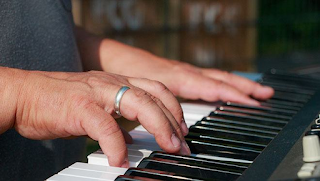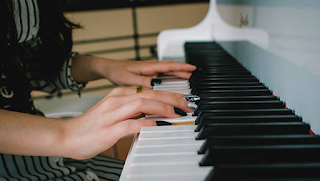Can an adult learn to play
There is an opinion in society that an adult cannot learn to play a musical instrument. Allegedly, in adulthood it is impossible to develop an ear for music, flexibility of fingers, and learning is worse. But in fact, it has little to do with real life.
 |
| It's never too late to learn how to play the piano! |
In children, the brain is indeed more flexible and neural connections are formed faster, but this is where the pluses end. While an adult who independently decides to master the piano has huge advantages:
- perseverance to rehearse at least 30 minutes daily;
- life experience in order to quickly respond to the teacher's comments and make adjustments to their actions;
- long fingers, which are easier to play even complex melodies;
- full control of your body, which will allow you to use both hands and master the material faster.
But the most important thing that distinguishes an adult from kids is motivation. Children often go to music school under the pressure of their parents, and they treat rehearsals rather superficially. They have no personal interest, without which the material is much more difficult to digest than with sincere interest.
You can learn to play the piano at any age if you have the appropriate desire and free time. And you can get the result even earlier than schoolchildren.
What is needed to learn the game
Ideally, if you can get a real piano to practice on a full instrument. People often give it away for free, it is enough to organize pickup. But in modern apartments there is often not enough space for it, so you can consider an electrical analogue (synthesizer).
In addition to the instrument itself, you need to buy a book of music for beginners, theory books on musical notation and tutorials. In the modern world, it is more convenient to learn from video materials, where you can immediately listen to the melody, clearly see which keys to press and at what speed.
If you can afford to study with a tutor or at a music school, be sure to take advantage of it. The teacher will be able to immediately put the correct posture and position of the hands, notice and correct mistakes, explain incomprehensible topics in more detail.
In addition to directly playing music, it is necessary to improve general musical literacy.
Hearing exercises
Musical ear can be developed in an active and passive way. The first is independent singing, and the second is listening to other people's songs and music. In addition, you should pay attention to musical dictations, the definition of intervals and chords by ear. There are special applications to learn how to identify notes and intervals by ear.
Examples of useful applications: Music Theory Pro, Rhythm Sight Reading Trainer, Music Theory and Practice.
Musicians have special exercises for developing musical ear:
- Scales . Sing all the notes in order from C to C. First up, then down. Check the correct sound with a special application, or by pressing the keys of an instrument for comparison.
- Sing songs. Launch your favorite songs, the lyrics of which you know well, and sing along to the performer, trying to hit the notes. You can play music on headphones and record your voice without extraneous sounds to assess the level of match.
- Intervals . Humming notes, keeping different intervals between them.
- Follow the notes. Turn on a familiar melody, and look at the sheet with the notes of this song. The exercise develops the inner ear of the musician well.
- Play a tune. Try to play a familiar melody without notes, just typing it by ear.
- Guess the note . Close your eyes and press any key on the instrument. Try to identify the note by the sound. Test yourself and repeat the exercise.
Learning to read music
You need to learn how to read sheet music in order to play even unfamiliar melodies. Without this skill, it is impossible to become a real musician.
The theory can be learned from classic textbooks, where basic things are told:
- arrangement of notes on the stave;
- duration;
- key;
- the size;
- alteration, etc.
Instead of a textbook, you can use our article “how to learn to play from notes”, which provides all the necessary information in a simple and understandable way.
Correct position behind the tool
In music schools, a lot of attention is paid to the position of students for instruments. Proper fit will provide the necessary freedom of movement, and the body and hands will not become numb from long sitting.
It is important to observe 5 key points:
- Landing . Adjust the height of your chair so that your elbows are at or above the level of the keys (keyboard at navel level). Lower your elbows down, keep them perpendicular to the keyboard, and a short distance from your body.
- Chair position . It is not necessary to occupy the entire surface so as not to shift the center of gravity. You only need to occupy its tip (1/3) or half, then you will be flexible enough to play freely on the entire surface of the keyboard.
- Distance to the instrument . Keep in the middle of the keyboard so that you can reach both the right and left edges. There should be a gap of about 30 cm between the body and the piano so that you do not have to additionally stretch your hands to the keys.
- Leg position . They should stand firmly on the floor, leaning on the entire foot. The legs are bent at the knees almost at a right angle.
- Posture . The back should always be straight, but do not protrude the chest forward. Watch the position of the shoulders - they should not rise. The hands are relaxed.
It is very difficult to independently control compliance with all points, especially when you need to press the pedal or reach for the far key. Just make sure that you do not have stiffness and fatigue in the body. If you feel uncomfortable, take a break and stretch. Get back to work in the correct position.
Understanding the accompaniment
The accompaniment influences the mood and character of the music. It includes:
- Rhythm is the duration of sound and pause.
- Texture - the style of playing (for example, with arpeggios, chords are taken sequentially one after another).
It is chosen depending on the desired mood of the melody.
Donot period of learning to play the piano
You can learn to play the piano without learning musical notation. If you play for yourself at home, you may not know a single note at all, but simply play simple melodies, following an example from the Internet. More details about this method will be written later. Now it is important to overcome the fear of the instrument, and get used to it.
Get used to the tool
You need to get comfortable and get used to the piano. Get rid of fear and trembling before him so that he becomes just a brush in your hands.
- Practice proper seating behind the instrument.
- Learn to hold your fingers correctly on the keyboard.
- Press the keys, listen to the sounds.
- Change the rhythm and tempo of keystrokes.
- Step on the pedals and watch the sound change.
Free improvisation
Move your fingers over the keys, and try to play a familiar melody. Most popular children's songs can be played with literally three notes in one octave. You can pick them up by ear.
Instead of other people's songs, you can come up with your own. Play the keys in different sequences, changing rhythm, tempo and style to create something new.
Learning the keyboard and notes
A standard piano keyboard has 88 keys (of which 52 are white and 36 are black). They are divided into 7 octaves, and 4 additional keys.
White keys go in turn:
- Before.
- Re.
- Mi.
- F.
- Salt.
- La.
- Si.
It is from these 7 notes that an octave consists, after which the next octave begins a little higher from the same notes (do, re ...).
The DO keys are to the left of the two black keys. Octaves start with them.
Black keys are also repeated in each octave, but they are presented in two groups: two and three keys.
Three chord songs
Having mastered a little with the keys and notes, you can go directly to playing your first melodies. You should always start with the simplest, so choose melodies from 3 notes.
A triad is a three-note chord.
Simple songs:
- "Geese".
- "Little Christmas Tree"
- A. Pugacheva "A Million Scarlet Roses".
- "The moon shines, the clear one shines."
- Gypsy girl.
Find other simple melodies on YouTube that you can play with three fingers.
What can help in learning to play without knowledge of music
You can play the piano even without knowing the notes. For this, special programs and applications have been created on the phone that will help you play any songs you want from scratch.
How the method works
Synthesia visually shows which keys to press, in what sequence and how long to hold them. Just press "falling notes" in time to play any melody.
The application can be downloaded to a computer (Windows, MacOS) or to a phone (Android, iOS).
If you have an electronic piano or midi keys, you can connect it directly to the program and it will see if you pressed the correct key. There are models that themselves highlight the color of the keys that you need to press.
Similar programs
Synthesia is the most famous service that is very popular. But there are other applications that are in no way inferior to it, and in some ways even surpass it.
- Flowkey is an application for the phone. A huge library of melodies, flexible playback speed settings. The screen displays the musical staff and shows the position of the pianist's hands on the keys. You select the desired tempo (slowest at the beginning, and normal at the end of the melody) and then play the piano. The program continues to move through the notes only if you have correctly pressed the key. Benefit: You can play a normal piano and the Flowkey will detect the sound of the pressed key.
- Simply Piano can work like the previous applications, but with additional features. It has built-in step-by-step training with daily tasks for beginners. They will allow you to master musical notation step by step, master different pieces of music and improve your skills.
- Yousician - learning in a game form, where the tasks are reminiscent of the popular Guitar Hero game.
You can find other services, applications and programs, but these are the ones that stand out from the rest.
Where to find midi files
The programs described above have their own library of melodies, but it may not be enough. If your favorite song is not available, you can add it yourself. You need to find it in midi file format.
- Midistock.ru is the most famous site with a large database of midi files of various musical compositions.
- Rusmidi.com is a Russian site where you can search for Russian-language novelties and folk songs.
- In the Yandex, Google or Bing search engine, enter the query "song_name midi file". Download the file from one of the sites in the issue.
Connecting the Digital Piano to the App
An acoustic piano can't be connected directly to the app, so you'll have to rely on your phone's microphone and the app's sound pickup functionality.
The digital piano needs to be connected via usb to a computer, laptop or phone, and specify the device in the settings.
Motivation for a beginner to play the piano
Starting a new business is always scary and very difficult, and sometimes you can give up. At such moments, it is very important to fill yourself with motivation in order to survive a difficult situation and move on.
Try to find like-minded people to push each other forward.
The techniques described below will help not to abandon classes in moments of weakness.
- Set a goal for yourself . You need to understand in advance and write down on a piece of paper the reasons why you want to learn how to play the piano. Do you want to compose your own melodies? Play perky songs for children? Learn 3-5 favorite pieces? Or do you want to become a professional pianist? You need to clearly imagine the moment of achieving the goal in order to further understand “I have achieved what I wanted!” When the going gets tough, close your eyes and imagine a moment of triumph to keep you motivated.
- See video . Make a selection of videos on YouTube where musicians play your favorite music. Try to choose videos where the keys and hands of the pianist are visible so that you have a desire to repeat.
- Play along with the soundtrack . Start a backing track or backing track, and play simple harmonies from the melody. In combination with the background sound of the song, you will get the feeling of being involved in its creation, which will fill you with the desire to continue improving yourself in order to play the melody completely on your own in the future.
- Speak in public . Even if you have mastered only 2-3 simple melodies, you can already play in front of an audience. Start with children - this is the most unpretentious audience if you choose perky children's songs. Parents, grandparents, spouse, friends and other close acquaintances will gladly support your undertaking.
- Track progress. Record your musical performances and post them on social networks or YouTube so that you can look back over time and clearly see the difference. You can publish in private channels so that no one but you can see.
How to interest a child
It is difficult for children to maintain interest in one activity for a long time. Especially if they did not decide to do it on their own, and their parents, against their will, enrolled in a music school.
Due to their age, the child cannot calculate plans for many years ahead, and evaluate the usefulness of musical skills in the future. He needs to be motivated in other ways.
- Surround him with music. Play classical music or his favorite cartoon songs at home and in the car. Take them to the Philharmonic, launch videos with child musicians who enjoy playing the piano and create masterpieces.
- Ask to be taught. Take an active interest in your child's progress and ask for help. Ask about different playing techniques, teaching methods, combinations of notes, or ask to play specific melodies. Children are very flattered when they know something better than adults.
- Learn through games. There are many playful music learning exercises to turn your learning into an interesting adventure. Daily tasks, rewards, bonuses and just an exciting process will allow the child to effortlessly master musical theory.
If the child categorically refuses to play music, it is worth talking to him without pressure and screaming. Try to find out the specific reason for the failure, and then solve it. He may not like the teacher or the training program, he is not interested in playing boring "adult" tunes. It could also be that overwork causes fatigue.
Listen to your child and go to a meeting, because music is only a part of life, and your relationship is much more expensive.
At any age, you can start playing the piano and succeed. You can even master the instrument yourself, even if it is not easy. But everything is possible if you set a goal and train regularly.






